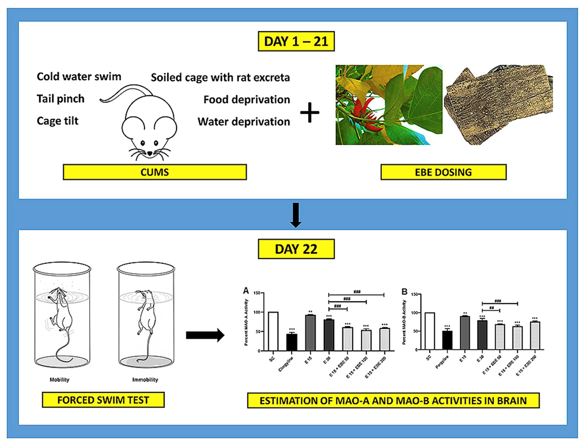

Anti-depressant activity of Erythrina variegata bark extract and regulation of monoamine oxidase activities in mice
Jeanette Martins, S. Brijesh*
Journal of Ethnopharmacology, Volume 248, February 2020, 112280 (Impact Factor: 3.414)
Sunandan Divatia School of Science, NMIMS (Deemed-to be) University, 3rd Floor, Bhaidas Sabhagriha Building, Bhaktivedanta Swami Marg, Vile Parle (W), Mumbai, 400 056, India
*Corresponding author
Abstract
Ethnopharmacological relevance: Erythrina variegata,commonly referred to as ‘Indian coral tree’ belongs to theFabaceaefamily. It is a plant native to the coast of India, China and is distributed in tropical and subtropical regions worldwide. In traditional medicine,E.variegatais known to exhibit anxiolytic and anti-convulsant activities and has been used as a nervine sedative. As per the Indian Materia Medica,E.variegatabarks have been traditionally known to act on the central nervous system. However, there is a lack of data demonstrating this.
Aim of the study: Our study focuses on previously unreported anti-depressant activity ofE.variegatabark ethanolic extract (EBE) and determination of its mechanism of action possibly through regulation of monoamine oxidase activity in mouse brain homogenates.
Materials and methods: EBE was characterized using standard protocols for phytochemical analysis, followed by liquid chromatography-mass spectrometry (LC-MS) and gas chromatography-mass spectrometry (GC-MS) analysis. The compounds in EBE (previously reported for anti-depressant activity), were further studied by LC-MS/MS and GC-MS/MS analysis. Anti-depressant activity of EBE (50, 100, 200 and 500 mg/kg) was evaluated in Swiss albino mice using acute and chronic tail suspension test (TST) and forced swim test (FST) models. Furthermore, the possible mechanism of action of EBE was evaluated using the chronic unpredictable mild stress (CUMS) model, wherein inhibitory effects on monoamine oxidase (MAO) A and B were assessed by spectrophotometric-chemical analysis in mouse whole brain homogenates.
Results: EBE showed significant reduction in immobility time periods in both TST (acute: 50, 100 and 200 mg/kg and chronic: 100 and 200 mg/kg) and FST (acute: 200 mg/kg and chronic: 100, 200 and 500 mg/kg) models. Moreover, the locomotor activity test confirmed that acute and chronic administration of EBE did not significantly affect the motor activity of mice. In the CUMS model, EBE when administered alone (100 and 200 mg/kg) and in combination (50, 100 and 200 mg/kg) with escitalopram (15 mg/kg), showed significant reductions in immobility time periods compared to the control group, in the acute FST performed on 22nd day of CUMS. Furthermore, when administered alone (50, 100 and 200 mg/kg), EBE showed significant inhibition in MAO-A and B activities compared to the control group. When used in combination, EBE (50, 100 and 200 mg/kg) showed synergistic action with escitalopram (15 mg/kg), resulting in significantly greater inhibition of MAO-A and B activities, compared to both EBE alone and escitalopram alone. Phytochemical analysis of EBE revealed presence of sugars, steroids, glycosides, alkaloids and tannins. LC-MS, LC-MS/MS, GC-MS and GC-MS/MS analysis identified components in EBE, previously reported for their anti-depressant activity.
Conclusions: The study thus concluded the anti-depressant like activity of EBE. The study identified components present in EBE that may be responsible for its anti-depressant activity. The possible mechanism of action of EBE was also investigated in the CUMS model, wherein inhibitory effects of EBE on MAO-A and B activities in the mouse brain were demonstrated. Furthermore, the study confirms the traditional use ofE.variegatabarks in CNS related activities through its anti-depressant like activity.
Online Link of the paper - https://www.sciencedirect.com/science/article/pii/S0378874119302818?via%3Dihub
Graphical abstract
